Explore our Climate and Energy Hub
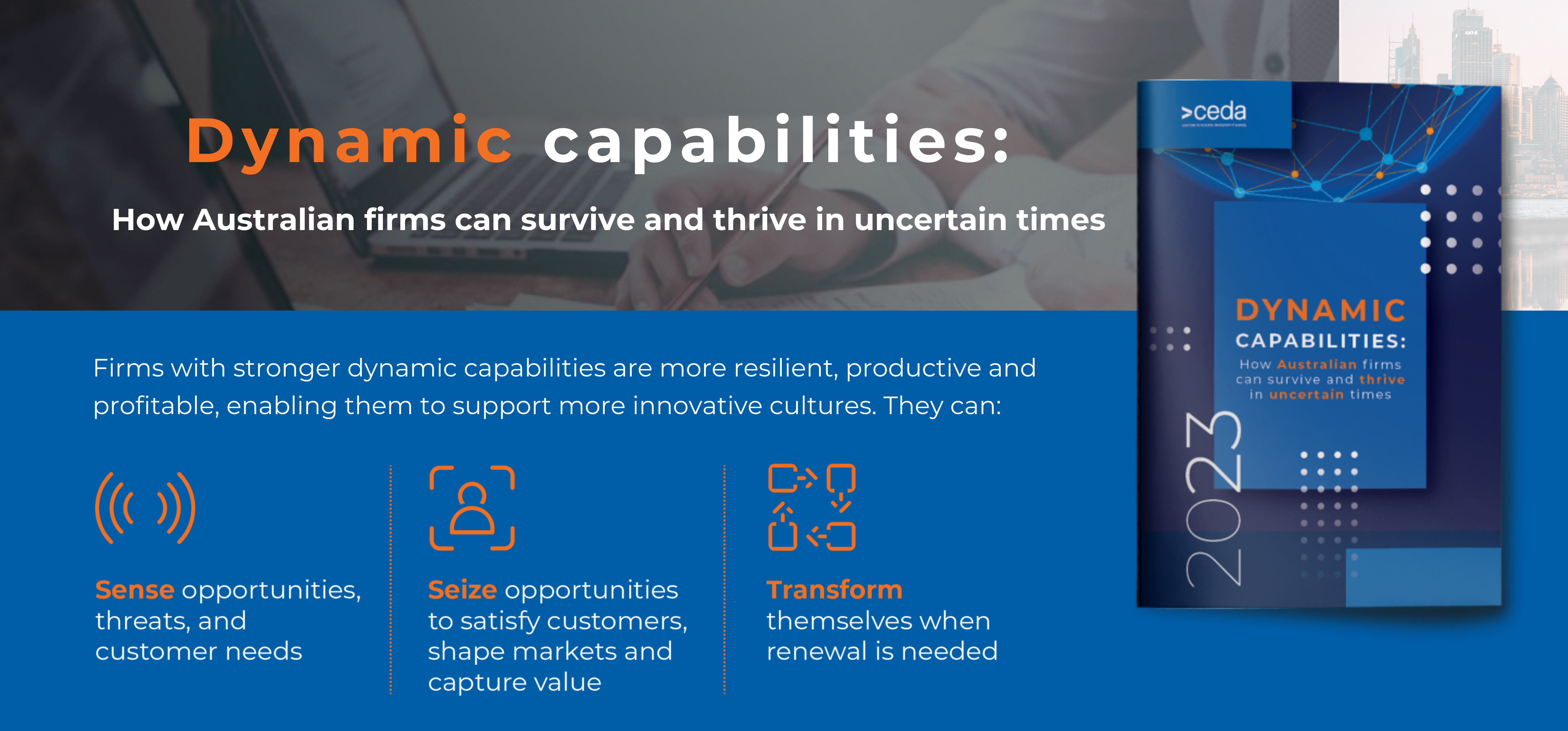
Australia has a productivity problem.
It has been critical to our rising prosperity and living standards, contributing more than 80 per cent of our growth in real gross national income per capita over the past 30 years.
But labour productivity growth has fallen to a 60-year low, and the gap between Australian firms and the global frontier is widening.
Climate change, heightened global tensions, a large and growing services sector and an ageing population are now all major challenges. Heightened inflation, capacity constraints and slow wages growth across the economy are compounding these difficulties.
Businesses need to know how to survive and thrive in this uncertain environment. What happens within businesses – or firm-level capabilities – is more important than ever. Their capabilities are critical not just for their own success, but also for our economic growth, productivity and innovation
Dynamic capabilities
Dynamic capabilities: How Australian firms can survive and thrive in uncertain times is the first report in CEDA’s new series on business dynamism and competitiveness. It explores the dynamic capabilities of Australian businesses, of which little has been known until now.
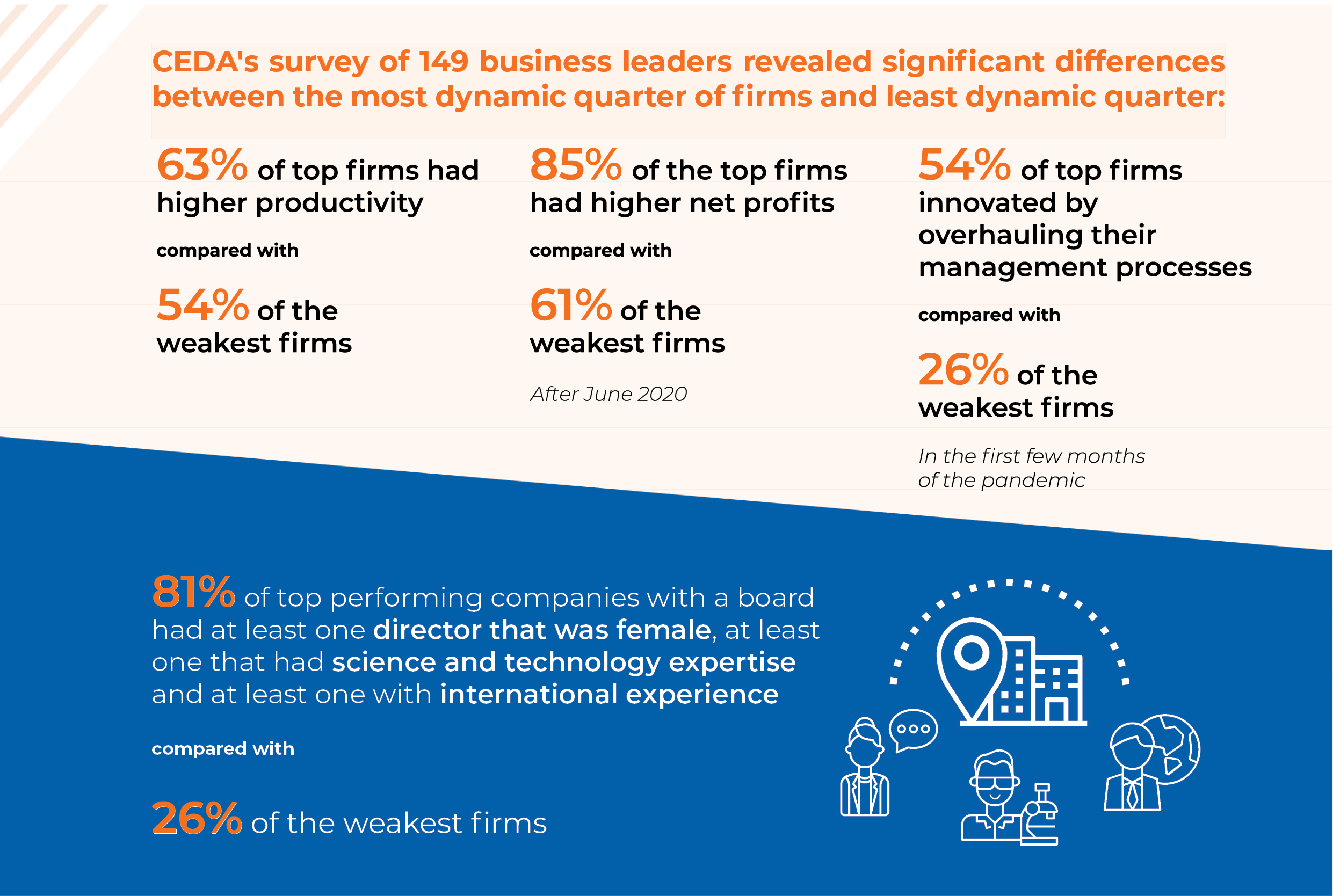
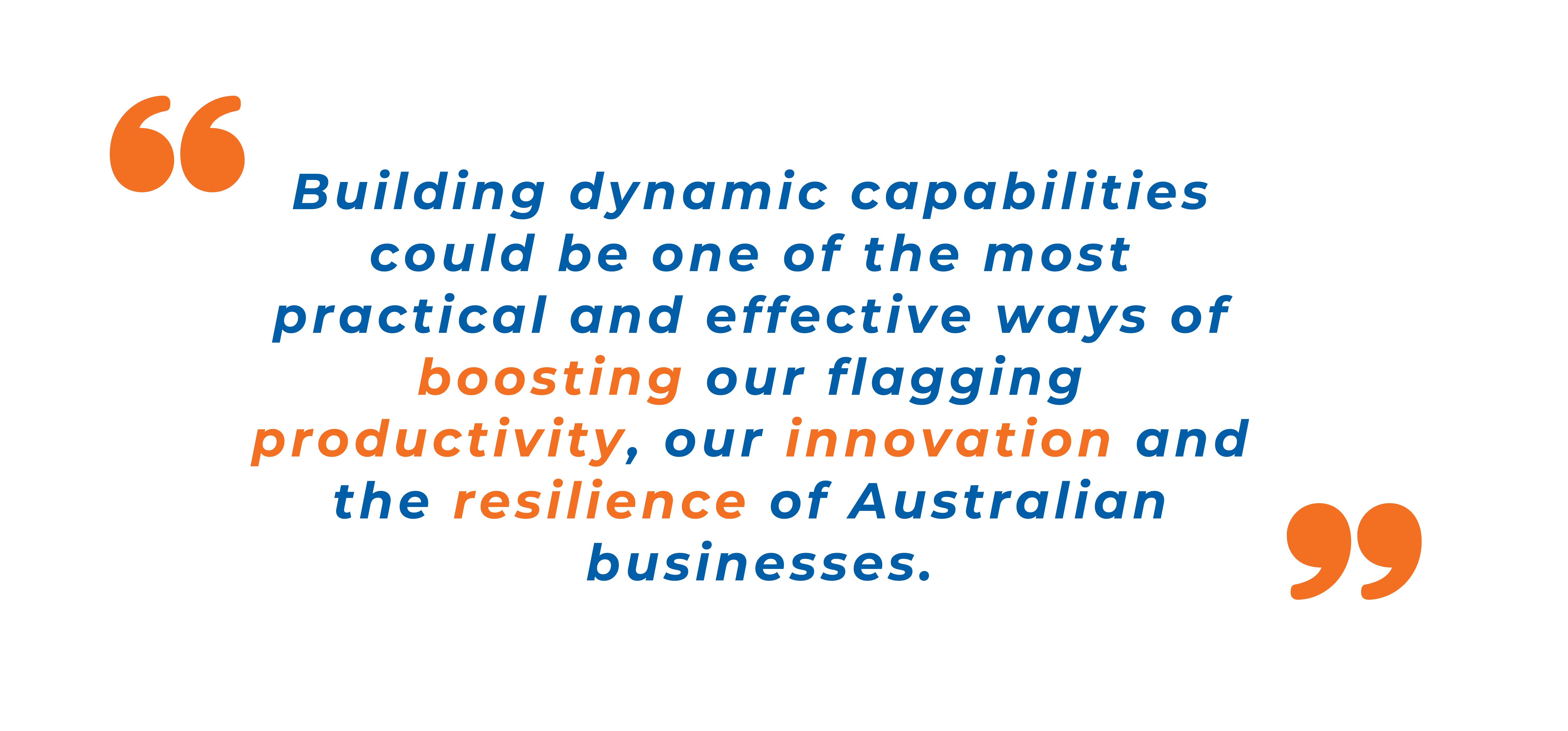
There are two types of firm-level capabilities.
- Ordinary capabilities are the basic skills needed to run a business in normal times. They are largely operational and focused on efficiency.
- Dynamic capabilities are more forward looking and strategic. In environments that are highly volatile, uncertain, complex and ambiguous, these capabilities help businesses to maximise their chances of long-run survival and success.
Firms with strong dynamic capabilities can:
- Sense opportunities, threats and customer needs;
- Seize opportunities to satisfy customers, shape markets and capture value; and
- Transform themselves when renewal is needed.
This cycle of sensing, seizing and transforming is essential for ongoing viability and success in a world of changing customers, markets, technologies, and a dynamic environment. Firms with stronger dynamic capabilities are more resilient, productive and profitable, enabling them to support more innovative cultures.
Little is currently known about the dynamic capabilities of Australian businesses. That’s why CEDA, with the University of Technology Sydney (UTS), has conducted the first broad survey of dynamic capabilities of Australian businesses.
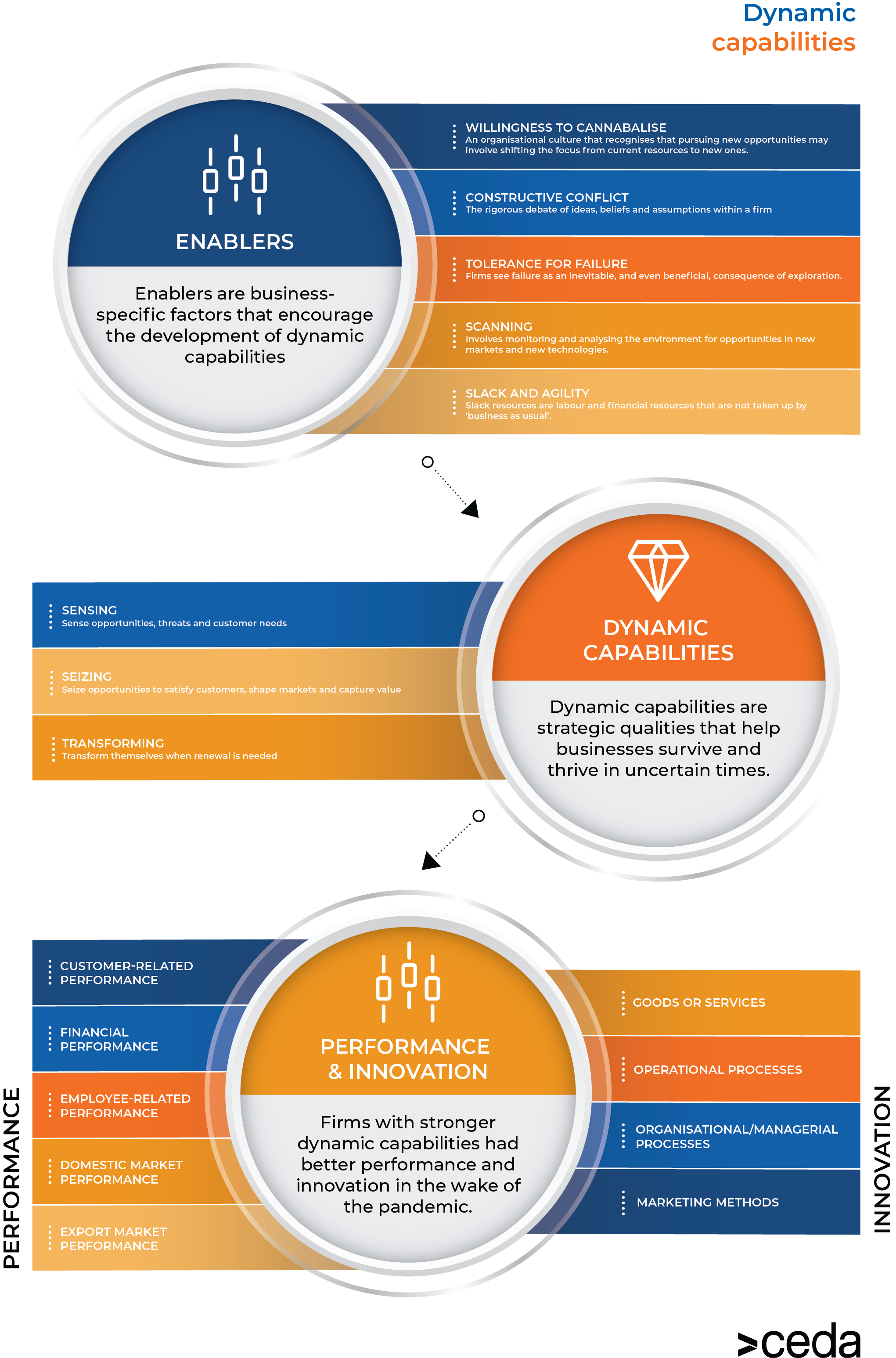
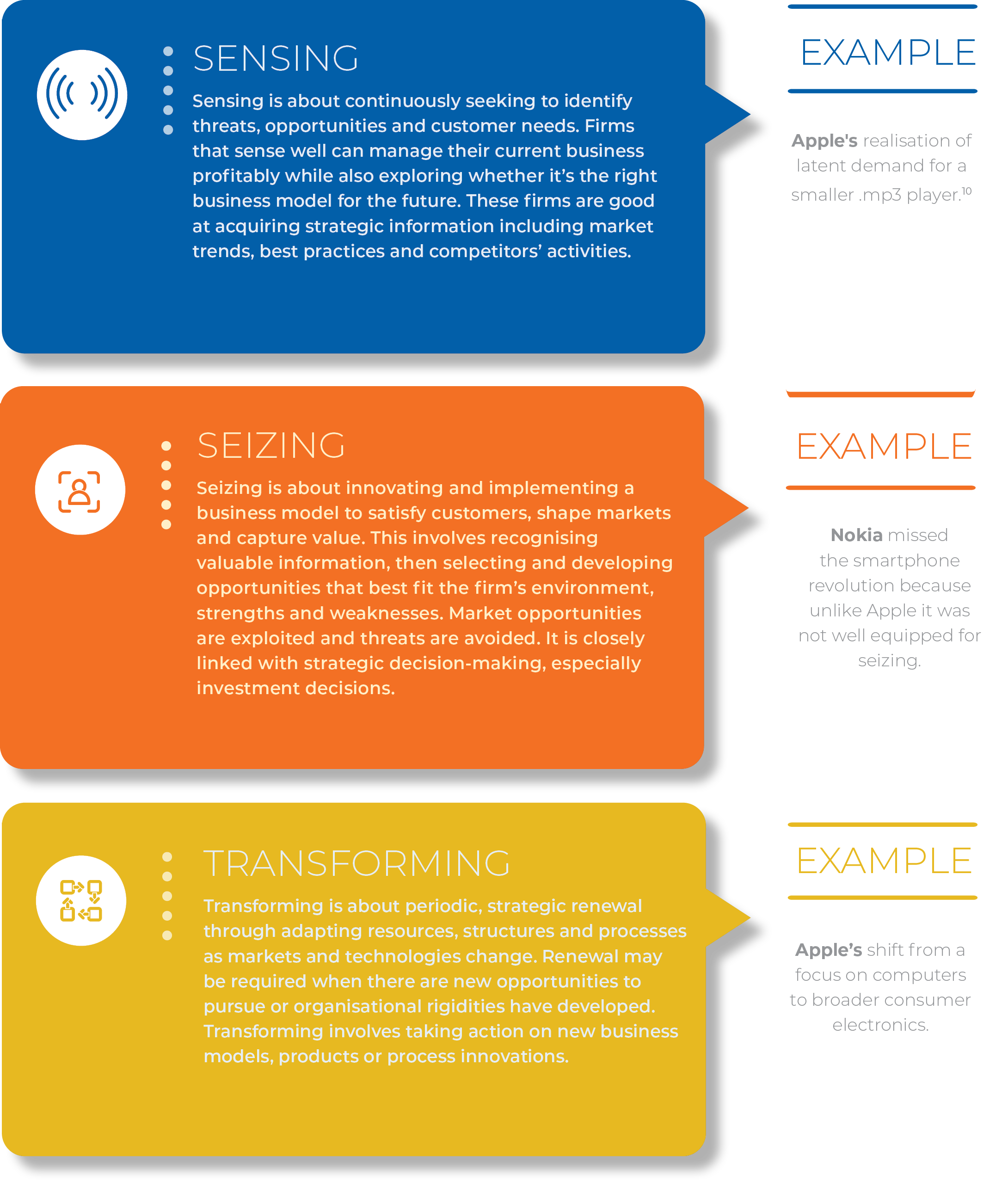

Report Authors
Melissa Wilson
Senior Economist, CEDA
Melissa Wilson is Senior Economist (SA) at the Committee for Economic Development of Australia (CEDA). She also has more than a decade of experience as an economist at the Reserve Bank of Australia (RBA), where she worked in a broad variety of areas, including the RBA’s business liaison program, overseas economies and international relations, labour markets, domestic markets, financial stability and public education. Melissa holds Bachelors degrees in Economics and Commerce from the University of Adelaide, an Honours degree (majoring in Economics) from the University of Melbourne, and a Masters of Economics from the University of New South Wales.
Dr. Renu Agarwal
Professor in Management, UTS Business School
Dr. Renu Agarwal is a Professor in Management at the UTS Business School with expertise in Strategic, Operations and Supply Chain Management. Prior to joining UTS, Renu worked in senior management roles at the State Rail Authority (SRA) of NSW, OTC, Telstra Corporation and REACH. Renu is a globally acknowledged research leader in management practices and dynamic capability building, as well as the related areas of innovation, productivity, and management performance at the enterprise level. As an academic, Renu has been instrumental in leading mostly government commissioned projects including research projects funded by industry, professional bodies, as well as individual companies and organisations, with her academic outputs in top tier international journals. Renu has a Bachelor’s in Electrical Engineering from the Indian Institute of Technology, Kanpur India, Masters in Electrical Engineering from the University of Sydney and a doctorate from Macquarie Graduate School of Management, Sydney.
Dr. Wen Helena Li
Senior Lecturer, UTS Business School
Dr. Wen Helena Li is a Senior Lecturer at UTS Business School with research expertise in international business and strategy, in particular using a multidisciplinary perspective to explore corporate strategies (e.g., internationalisation, innovation, sustainability) and their financial and social implications. Helena’s research has appeared in top-tier management journals, and she also serves on the editorial reviewing boards of many prestigious journals and conferences. Helena has led and participated in projects commissioned by various levels of government in both Australia and China, with a strong focus on improving the capabilities of businesses and managers to sustain their global competitiveness. Helena holds a PhD degree from Zhejiang University, China.
Dr. Christopher Bajada
Professor of Economics and Research Director, Centre of Business Intelligence and Data Analytics UTS
Dr. Christopher Bajada is Professor of Economics and Research Director of the Centre of Business Intelligence and Data Analytics. Chris’ research is primarily in applied economics with an interest in business cycles, tax compliance, productivity, circular economy and management practices. Chris has published several research books, academic textbooks and refereed journal articles in top-tier journals as well as being successful in several national competitive research grants, including funding from industry, professional bodies and various state and Commonwealth governments. Chris has also held several university administrative positions including Associate Dean (Education) and Chair of the University’s Teaching and Learning Committee at UTS. Chris holds a PhD from the University of New South Wales.
1. Dynamic capabilities yield big economic dividends, especially in uncertain times
Firms with strong dynamic capabilities are resilient and can successfully navigate unexpected events with minimal disruption, rather than resorting to crisis management. For example, there is evidence that firms with stronger dynamic capabilities were more resilient during the Global Financial Crisis.
We analysed the link between dynamic capabilities and innovation during the pandemic, a recent period of deep uncertainty. We found that, all else equal, firms with stronger dynamic capabilities were more innovative in the first few months of COVID-19.
The most dynamic 25 per cent of firms also undertook more innovation in the wake of COVID-19 than the least dynamic 25 per cent of firms across all areas of innovation in the survey.
The most dynamic firms were better able to adapt and innovate in the highly uncertain COVID-19 environment. Sensing was particularly useful early in the pandemic, while transforming was most valuable across multiple forms of innovation. Given that transforming is a weakness for most Australian firms, lifting capabilities in this area could help to improve innovation.
We also found that firms with stronger dynamic capabilities performed better in the wake of the COVID-19 pandemic, especially from June 2020 onwards. This suggests that the innovations made early in the pandemic set firms up for success later on, and that dynamic capabilities were crucial in adapting to this shock.
All else equal, firms with higher scores had significantly better customer, financial and employee-related performance after June 2020. They also had significantly better employee-related performance in the first few months of COVID-19. Employee-related performance was measured across a range of metrics, including number of employees, as well as implementation of strategies to reduce employee turnover, and improve staff skills, satisfaction and commitment.
2. Australian businesses have significant room for improvement
Some firms had stronger dynamic capabilities than others, but almost all had room for improvement. Firms scored across the full range of possible outcomes (from an average response of 1 or “strongly disagree” to 6 or “strongly agree”) but were clustered around 4 to 5 (“slightly agree” to “agree”), with a mean score of 4.6. Almost 60 per cent of firms scored above the mean.
Within each category, differences between firms were also significant. The top 25 per cent of firms in each category had an average score of around 5.0 to 5.4 (“agree” or a bit higher). This was 1 point higher than the bottom 25 per cent in each category, which had an average score of around 4.0 to 4.6 (“slightly agree” or a bit higher). These differences point to considerable room for improvement and learning.
Transforming is hard. Firms must focus their efforts here. Previous research has shown almost one in three Australian CEOs believe their company won’t exist 10 years from now if they continue down the same path. The things that make a business successful today make it more difficult to change for tomorrow.
Business leaders are often reluctant to take assets and capabilities from an existing part of the business to grow a new part of the business, but ultimately this can be their downfall. Transforming requires managers to be bold and take smart risks to build competitive advantage.
3. Firms need to make space for capability building and exploration
Slack & agility was the enabler with the strongest relationship to dynamic capabilities. This is about firms having access to labour and financial resources that are not tied up in “business as usual” to build competencies and pursue longer-term opportunities as they arise. Slack & agility is an important enabler for all three capabilities, but particularly for transforming.
Being willing to cannibalise, or to scale up new areas of the business at the expense of existing sources of revenue, is particularly important for seizing new opportunities. Experts agree this is where a lot of firms fall short. Our results confirm this is very difficult for businesses to do.
Scanning the environment is particularly important for identifying new opportunities and threats. The weakest score in the scanning category was on effective engagement with researchers at universities. There has been a lot of focus on the relationship between businesses and universities in recent years, particularly through the Federal Government’s University Research Commercialisation Action Plan. Previous CEDA research identified collaboration between industry, academia and government as a key barrier to unlocking our innovation potential. Our results support this ambition.
Tolerance for failure is important for transforming capabilities. Firms scored relatively highly on this enabler, which is at odds with the common narrative of a growing culture of risk aversion among Australian businesses. At face value, this result suggests that risk aversion is not currently our biggest impediment, at least from a dynamic capabilities perspective.
4. Diversity matters for dynamism
Greater diversity within firms can help foster dynamic capabilities. Leaders’ experience is instrumental in setting firm strategy, structure and processes, which are all crucial for providing an environment in which dynamic capabilities are developed and maintained.
We found that firms with stronger dynamic capabilities had more diverse boards. Specifically, 81 per cent of top performing companies with a board had at least one director that was female, at least one that had science and technology expertise and at least one with international experience, compared with just 26 per cent of the weakest firms.
All three of these categories of diversity (female, science/technology experience and international experience) were related to a company’s sensing abilities. Having gender and professional diversity on their board was also related to a company’s ability to transform.
5. Areas with strong capabilities partly reflect economies of scale and Australia’s narrow industrial base
Both small and large businesses are vital to Australia’s economic success. Most businesses in the Australian economy are small-to-medium-sized enterprises (SMEs), making them the drivers of employment and productivity growth, while larger firms have a bigger impact on business investment. Dynamic capabilities are relevant to firms of all sizes, though particularly when management is shared across a team.
On average, larger businesses (with at least 200 full-time equivalent employees) had stronger dynamic capabilities than SMEs (average score of 4.8 versus 4.4). Similarly, national firms (operating across all states and territories) scored higher than firms operating in a single state or territory (4.8 versus 4.5).
The industries with the highest average scores were finance & insurance services and mining. This is consistent with Australian research on ordinary capabilities in which finance & insurance services and mining were among the industries with the highest share of firms in the top level of strategic management.
In contrast, the weakest average score was for the production & distribution industry group, which includes manufacturing; construction; transport, postal & warehousing; wholesale trade and retail trade. Again, this is broadly consistent with the Australian research on ordinary capabilities showing manufacturing, construction, and transport, postal & warehousing were among the lowest tiers of strategic management capability.

Dynamic capabilities: How Australian firms can survive and thrive in uncertain times
DownloadFor business leaders
- Dynamic capabilities help companies perform better in uncertain environments. Business leaders need to be open to feedback and understand their firm’s capabilities, where they are lacking and how to improve.
- Businesses must build their dynamic capabilities, including through education and training. New micro-credential programs could help in the short term. Over time, more business schools should teach dynamic capabilities.
- More firms need to prioritise innovation over efficiency. To do this, businesses need to find the people, time and money to build their capabilities, take advantage of new opportunities and position for the future.
- Australian businesses must get better at transforming. Leaders need to embrace renewal and change and take smart risks in the face of uncertainty.
- We need more diverse leadership at executive and board level.
For governments
- Innovation policy should encourage businesses to build dynamic capabilities. For example, Australia should learn from overseas programs such as the frontier firms training program in New Zealand.
- Onerous compliance regimes can hinder the development of dynamic capabilities. While regulations are important, governments should ensure they are well-designed and that the level of burden they’re imposing does not stifle innovation, especially for small businesses.
- Attracting both skilled migrants and talented expats back to Australia can strengthen domestic capabilities. The Federal Government should provide a fast-track visa for highly skilled executives, as CEDA has previously recommended.
- Governments will need to adopt dynamic capabilities in the delivery of services such as aged care, disability services and welfare as they increasingly face similar demands as for-profit businesses amid rapid digital transformation, rising community expectations and funding pressures.
- Building dynamic capabilities is an investment in resilience in the economy. Dynamic firms are adaptable and can navigate unexpected events with minimal disruption, reducing the need for crisis management.
Resources includes: agriculture; forestry and fishing; and mining.
Production & distribution includes: manufacturing; construction; transport, postal & warehousing; wholesale trade and retail trade.





